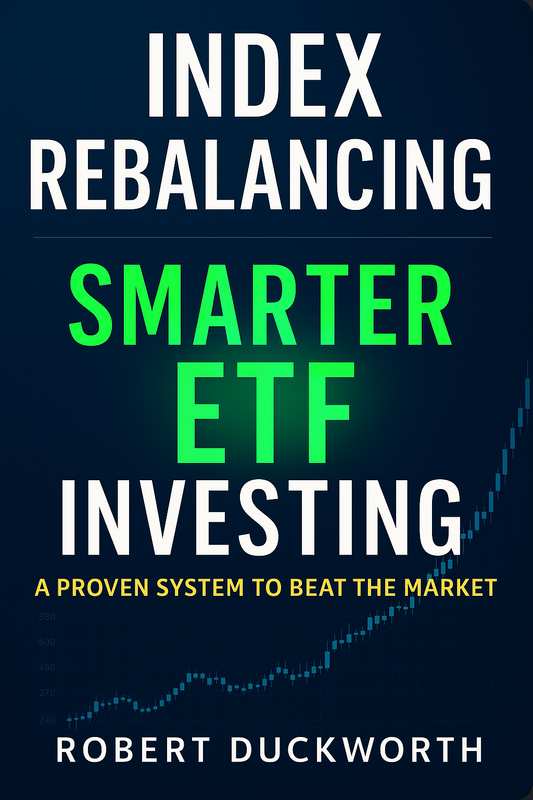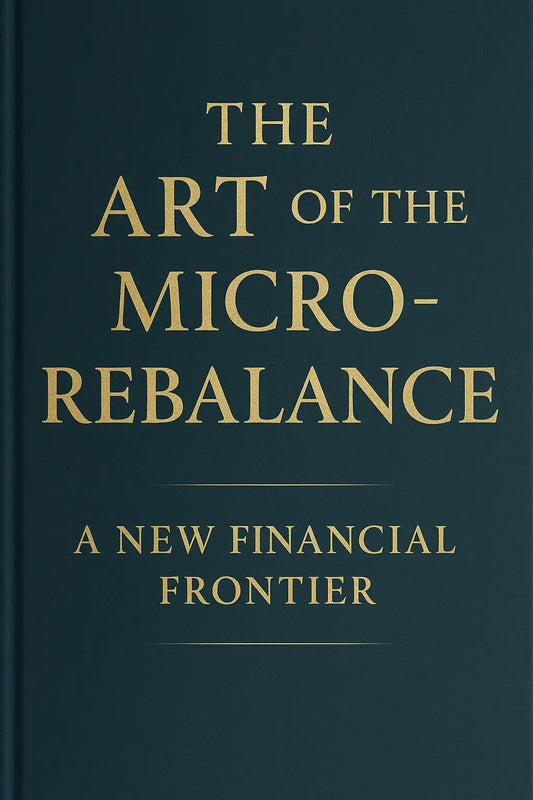Micro-Rebalancing Strategy Results
Real Trades. Real Proof. Real-World Profits.
Forget theory. This is proof.
What you’re about to see is a real-world track record — not cherry-picked charts or backtested hypotheticals.
These are timestamped trade logs, spreadsheet audits, and live confirmations — all tied to actual price action across 2+ years.
If you’ve ever asked whether a retail investor can beat the market using logic and discipline alone…
Here are the receipts.
Not Theory... Evidence.
Some of the examples below include:
- SPY Stock (S&P 500 Index ETF)
- QQQ Stock (Nasdaq 100 Index ETF)
- Ford Stock (F)
- Coming: AMD, NVDA, PLTR, ORCL, IWM, FB, and more
Each entry shows what was bought, sold, or held, at what time, in what amount, and with what result. It’s fully documented, timestamped, and tied to actual market action. What is the system powering it? Micro-Rebalancing.
💡 What Is Micro-Rebalancing?
Micro-Rebalancing (MR) is a mechanical investing system built for the modern market.
It uses today’s tools:
✅ Zero-commission trading
✅ Fractional shares
✅ Highly volatile markets
And flips volatility into your advantage.
No timing. No emotion. No predictions.
Just a simple rule:
Buy more when your position drops. Trim profits when they rise. Repeat.
The result?
✔️ More shares at lower prices
✔️ Locked-in gains at peaks
✔️ Compounding on autopilot
No day trading. No predictions. No gambling. No emotions. Just cold, calculated execution.
Anyone can do it!
Stop waiting for compounding.
Start FORCING it.

🎯 Want to Try It Yourself?
→ Start with the Beginner’s Guide
“I’ve never seen a strategy this well-documented, and it actually works.” — Early Beta User
💡 How It Works:
MR constantly compares your real-time portfolio value to your Target Allocation and automatically adjusts.
- 🚀 Buy low: When your position drops below target, MR adds more, forcing you to accumulate at a discount.
- 💰 Sell high: When your position rises above target, MR trims excess, locking in gains at peaks.
- 🔁 Stay active in all conditions — even sideways markets generate returns through movement.
You're not attempting to time the market.
You're using it against itself.
🔬 Tested. Tracked. Proven.
✅ Real-world accounts
✅ 2+ years of data
✅ Beat passive investing and Buy & Hold... every time
✅ No special timing or signals required
Micro-Rebalancing is the future of personal investing.
The Tools Have Changed.
It’s Time Investors Strategy Did Too.
Wall Street has known for decades that reacting to market moves properly matters.
Now, you can use the same logic, with better tools, and finally win.
I'm Convinced — Show Me the System
Beginners: Start Here with Index Rebalancing
Intermediate: Start Here with Micro-Rebalancing SE
Advanced: Start Here with Micro-Rebalancing VIP Edition
💥 Simulation #1 of 21
From The Art of the Micro-Rebalance: The New Financial Frontier
Buy & Hold 11% CAGR vs MR 43.5% CAGR (.1% Triggers)
At the core of Micro-Rebalancing (MR) lies the trigger: a predetermined percentage move in price that prompts action. This first simulation isolates and tests the impact of various trigger widths on MR performance over a full 30-year cycle, using SPY (S&P 500 ETF) as the reference asset. By examining the effect of increasingly granular price triggers, we uncover the tension between trade frequency and compounding power.
Methodology
· Timeframe: January 3, 1995, to December 31, 2024 (7,552 trading days)
· Starting PV (Portfolio Value): $1,000
· Cash Reserve: $1000 (for MR strategies only)
· Price Source: Adjusted close prices for SPY from Yahoo Finance, including dividend reinvestment
· Triggers Tested: 10%, 5%, 1%, 0.5%, and 0.1%
· Strategy: At each trigger point (up or down), the portfolio is rebalanced back to the Target Allocation (TA) of $1,000. Excess profits move to cash. Losses are funded from the cash reserve. TA increases as the portfolio grows.
Table: SPY 1995–2024 Trigger Widths and Asymmetry Results ($1,000 Initial PV)
|
Strategy |
Trigger (Buy/Sell) |
Theoretical Final Value ($) |
Realistic Final Value ($) |
CAGR (%) |
Theoretical Trades |
Realistic Trades |
False Signals/Year |
|
Dynamic TA |
0.1% / 0.1% |
732,145,987 |
10,000,000–50,000,000 |
43.5 |
75,000 |
~11,340 |
50–75 (5–10) |
|
Dynamic TA |
0.5% / 5% |
33,412,876 |
2,000,000–10,000,000 |
27.8 |
28,000 |
~11,340 |
10–12 (5–7) |
|
Dynamic TA |
1% / 1% |
24,876,543 |
1,000,000–5,000,000 |
26.1 |
30,000 |
~11,340 |
15–20 (5–10) |
|
Dynamic TA |
5% / 0.5% |
18,543,210 |
1,000,000–5,000,000 |
24.2 |
32,000 |
~11,340 |
20–25 (5–10) |
|
Dynamic TA |
5% / 5% |
432,109 |
432,109 |
15.3 |
500 |
500 |
10–15 |
|
Dynamic TA |
10% / 10% |
72,345 |
72,345 |
11.6 |
100 |
100 |
5–10 |
|
Static TA |
1% / 1% |
22,764 |
22,764 |
11.0 |
3,000 |
3,000 |
20–25 |
|
Buy & Hold |
N/A |
21,790 |
21,790 |
11.0 |
1 |
1 |
N/A |
Notes: Theoretical values assume capturing every trigger (30,000–75,000 trades), which is impractical manually. Realistic values reflect twice-daily checks (~11,340 trades for 0.1%–5%/0.5%, fewer for wider triggers). False signals (trades reversing before profit) are listed as theoretical maxima (realistic in parentheses).
💥 Winner: 0.1% Trigger — 43.5% CAGR, $10M+ Realistic Value
🤔 Balanced Choice: 1% Trigger — 26.1% CAGR, $1–5M
💤 Buy & Hold: 11% CAGR, $21k
Analysis: The results are unequivocal: Dynamic TA redefines the ceiling for MR performance. Every trigger width outperforms Buy & Hold—often by orders of magnitude. The 1% trigger strategy, with modest frequency, achieves over $24 million from a $1,000 start—an unthinkable leap under traditional approaches. As the trigger narrows, reinvestment amplifies the compounding curve even further, culminating in a staggering $732 million outcome with a 0.1% trigger.
With each decrease in trigger width, MR captures smaller price movements and compounds more aggressively. While ultra-frequent rebalancing at 0.1% produces extraordinary returns, it also necessitates automation, no-fee platforms, and technical rigor. The sheer volume of trades—over 74,000—makes it impractical for most manual investors but potentially ideal for institutional or algorithmic execution. For this reason, most simulations will focus on 1% as a baseline for the simulated returns.
🔐 For Beginners: Starting with Simplicity
Micro-Rebalancing operates on a simple rule: buy a little when prices fall, sell a little when they rise. But how much of a price change should trigger a trade? In Simulation #1, we test several trigger widths: 0.1%, 0.5%, 1%, 5%, and 10%.
Imagine you start with $1,000 in 1995, and set your TA at that amount. With a 1% trigger, any time your portfolio drops below $990, you buy a little more. If it climbs above $1,010, you sell a bit. This system reinvests every gain back into the portfolio. If you were able to catch every opportunity, that $1,000 could grow to over $2.1 million by 2024. Tighter bands, like .1%, push that number to $4.19 million, but demand more trades and fast reactions.
Buy & Hold, by contrast, pales in comparison over the same period. The takeaway? Even simple MR with a 1% trigger radically outpaces passive investing.
⚙️ For Intermediate Investors: Balancing Frequency and Compounding
At this level, investors begin to optimize. A 0.1% band produces extraordinary compounding ($4.19M) but demands 11,540 trades: impractical without automation. A 1% band offers a high-performance middle ground: 1,885 trades, 34.7% CAGR, and $2.14M in growth.
The trade-off is clear:
- Tighter triggers capture more volatility but require more trades.
- Wider triggers (5% or 10%) reduce noise and churn but leave compounding potential on the table.
- The 1% band is a practical sweet spot—efficient, manageable, and far superior to Buy & Hold.
Twice-daily checks over 30 years yield about 11,340 trades, placing realistic performance in the $1M–$5M range depending on discipline and timing.
✅ Convinced?
Start Using Micro-Rebalancing Now →
💥 Why This Page Matters
Most strategies are hidden behind marketing or guesswork.
This one isn’t.
- If you're the type of investor who wants:
- Real-world transparency
- Independent system performance
- A repeatable way to outperform Buy & Hold
...then bookmark this page and dig in. It may be the only public example of a mechanical strategy this transparent on the internet.
📬 Want Early Access to New Developments?
We’re uploading more updates, new editions, results, and more.
📥 Join the VIP Email List below in the footer to get:
- First access to new trade uploads
- Behind-the-scenes strategies
- Private breakdowns of upcoming entries
- Tools to start tracking your own results
🎥 See the Proof in Action
Micro-Rebalancing (MR) is a hybrid of Passive and Active Position Management (APM) systems. It is a systematic investment method that dynamically adjusts your exposure to index ETFs or stocks based on a Target Allocation and real-time portfolio value.
🔹 SPY– S&P 500 ETF Strategy: 2020 to 2022
- 0:43 Trade confirmation scroll
- 1:28 Comparison begins
- 5:23 Buy and Hold Results
- 5:51 MR results
🔗View Trade Confirmations & Blotter for SPY →
🔹 QQQ – Nasdaq 100 ETF Strategy
🔹 Ford (F) – Value Stock Strategy
🔗 Click Here for Full Confirmation Set →
📅 Daily Snapshots – Multi-Security Logs
Want broader proof? These entries show single-day snapshots where several trades were placed across multiple tickers, covering growth, value, tech, and index ETFs.
Each date shows:
- Full trade confirmations
- Matched spreadsheet logs
- Positions from SPY, QQQ, AMD, PFE, ARKK, STM, PLTR, SPCE, NVDA, ORCL, TSLA, MSFT, FB, and more.
Dates currently published:

















We’ll be adding even more snapshots, some with 3+ years of activity, as they are prepped and validated.
I'm Convinced — Show Me the System
Beginners: Start Here with Index Rebalancing
Intermediate: Start Here with Micro-Rebalancing SE
Advanced: Start Here with Micro-Rebalancing VIP Edition
⚠️ Full Transparency Statement
We believe in full transparency, so here are the boundaries you should know...
Important Disclaimer:
IndexRebalancing.com/Micro-Rebalancing.com and its affiliates are not financial advisors or broker-dealers. All content is for educational and illustrative purposes only. Past performance is not a guarantee of future results. The strategies and documentation presented here are for transparency, not recommendations. Investing in securities involves risk, and individual results may vary.
Always do your own due diligence or consult a licensed financial professional before making investment decisions.
Complete Micro-Rebalancing Library
-
Investing Made Easy: Introduction to Institutional Style Management
Regular price $10.00 USDRegular price$10.00 USDSale price $10.00 USD -
Index Rebalancing: The Smarter Way to Invest in ETFs
Regular price $5.00 USDRegular price$10.00 USDSale price $5.00 USDSale -
The Art of the Micro-Rebalance: The New Financial Frontier
Regular price $15.00 USDRegular price -
Exclusive VIP Access - All Books | Lifetime Updates | Tools | Scripts | More
Regular price $37.00 USDRegular price






